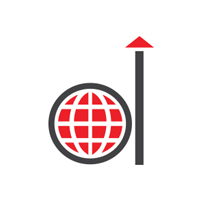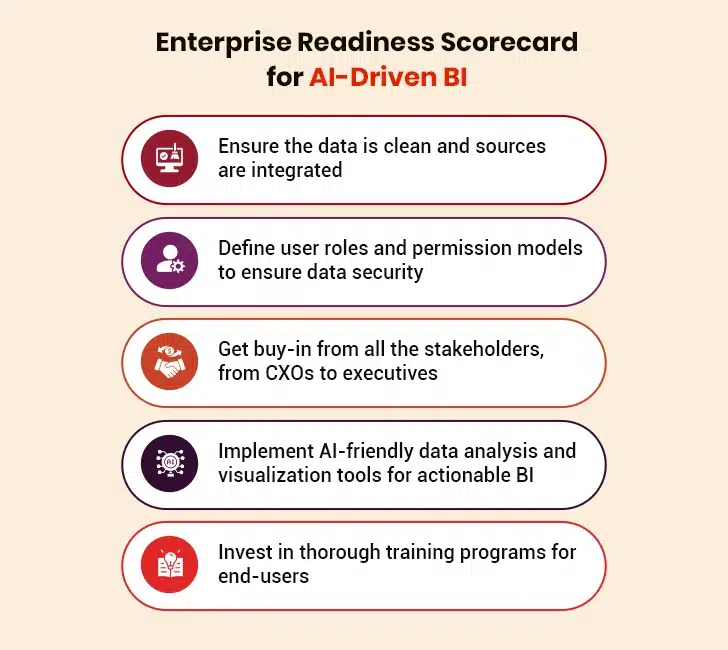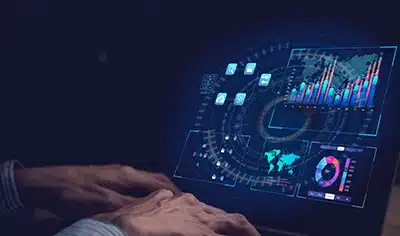The modern business landscape is highly data-saturated. For most parts, this data is usually unstructured or semi-structured. Moreover, the rate at which data is generated is overwhelming. Traditional methods of analyzing and visualizing data, once the gold standard, fail to manage volume, complexity, and the dynamic nature of modern data. Dashboards that once delivered value now struggle to keep up, providing limited, one-dimensional views of data that require manual interpretation. These also tend to be passive, offering insights only after the data has been processed, rather than in real-time.
This reactive approach to data is no longer valid, especially when businesses look to tap into fleeting opportunities. That’s where AI enters the game; it is an evolution that doesn’t just change how organizations visualize data but redefines it completely. AI data visualization, powered by predictive analytics and machine learning algorithms, empowers businesses to shift from static representations to dynamic, live interactions. Given these capabilities, the data visualization market size is projected to reach USD 18.36 billion by 2030, at a CAGR of 10.95% during the forecast period.
Imagine a dashboard that predicts what’s likely to happen tomorrow, next week, or next quarter. That’s the power of AI data visualization!
The paradigm shift from reactive guesswork to proactive strategic planning is important, especially in the dawn of autonomous intelligence. This is possible due to technology, precisely, AI for data visualization, capable of instantly processing and analyzing vast data streams, uncovering hidden trends, and visualizing actionable insights, clearly and intuitively.
AI-enabled data visualization tools can generate insights, adapt to changing data environments, and even make autonomous decisions. And as technology advances, legacy dashboards are replaced by smarter, more intuitive BI systems. These new systems don’t just visualize data, but also understand it, predict trends, and provide actionable recommendations, laying the foundation for autonomous intelligence.
Table of Contents
Core Capabilities of AI-Powered Data Visualization
- Automated Insight Generation
- Natural Language Interaction
- Predictive Analytics
- Real-Time Data Processing
Key Benefits of AI-Powered Data Visualization
Use Cases of AI-Powered Data Visualization Across Industries
Popular AI Data Visualization Tools
Future of Data Visualization with AI: From Traditional Dashboards to Autonomous BI
Core Capabilities of AI-Powered Data Visualization
AI data visualization tools have changed how companies understand and use data. These tools use ML algorithms, NLP capabilities, and predictive analytics to provide deep insights into complex datasets. They transform raw datasets into intuitive stories, enabling users to view and interact with data innovatively. Take a look at some of the core capabilities of an AI data visualization tool:
Automated Insight Generation
Traditional data analysis and visualization methods require human intervention to generate, interpret, and visualize the insights. Stakeholders relied on experts, such as data scientists and analysts, to interpret and visualize the data effectively. However, this process can be automated by integrating AI into the data visualization process. AI algorithms analyze datasets to identify patterns, trends, and anomalies that might be missed through traditional methods. This automation saves time and reduces the chances of human error.
Natural Language Interaction
One of the biggest advancements in data visualization is the integration of NLP capabilities. Users can interact with data using simple, conversational language instead of writing complex SQL queries. Suppose a stakeholder wants to know the sales of a particular product in the last quarter. The simple question: “What were the sales of this product in the last quarter?” will give them a visualized answer. Thus, users don’t need to be data science or coding experts to understand their data.
Predictive Analytics
Regular dashboards provide a snapshot of past performance, but data visualization with AI goes a step ahead by predicting future trends. These tools empower businesses to take a proactive rather than a reactive approach by analyzing historical data to predict future outcomes. For instance, retailers can use advanced tools to predict products more likely to be in high demand in the upcoming season. This capability helps businesses make smart choices and optimize their strategies.
Real-Time Data Processing
AI data visualization tools are designed to instantly process large volumes of data, equipping users with the latest insights. This real-time processing capability is essential for industries such as finance, healthcare, and manufacturing, where decisions must be made promptly based on the available data. Take the finance industry, for instance, where AI tools help analyze and visualize stock prices, currency rates, and market news in real time, enabling traders to respond to market shifts promptly.
Given all these capabilities, it is right to say data visualization tools with embedded AI are like the digital genie for decision-makers—stakeholders need to convey the query, and the tool presents the data in the most easily understandable and appealing visual. The best part is that AI visualization tools understand natural language queries, help with deeper data exploration, and allow users to create personalized, dynamic dashboards. Let’s understand how these capabilities add value to business, regardless of their size and scope.
Key Benefits of AI-Powered Data Visualization
Integrating AI in data visualization makes the entire process of representing insights smarter. It empowers businesses to move from static reports and dashboards to interactive visuals that show precisely what is needed. For instance, AI tools can detect subtle anomalies and emerging patterns, enabling proactive responses to business challenges or opportunities. This deep insight discovery provides a bigger, detailed picture of what’s happening across industries, ultimately, accelerating the process from data to action. Other than enhanced insight discovery, organizations can reap a lot more:
1. Democratization of Data Access
AI data visualization tools democratize data access by empowering non-technical users to understand data. These tools understand natural language queries, which lowers the barriers for employees, such as business leaders and product managers (essentially professionals with low or negligible technical background), to engage directly with data without relying on specialized skills. They can explore and analyze complex data and use the tools to create customized dashboards and intuitive visuals.
2. Increased Efficiency and Productivity
Businesses can use modern visualization tools to automate chart selection, data preparation, and insight generation. This not only reduces manual workloads but also accelerates reporting cycles. Moreover, AI visualization tools recommend the most effective visuals to present complex information based on user roles and preferences. This enables employees to make informed decisions while allowing data analysts to focus on strategic analysis rather than routine tasks.
3. Fostering Data-Driven Culture
AI integration enables real-time data processing and predictive modeling within visualization platforms. Users can monitor live dashboards that update automatically and leverage forecasts to anticipate future trends. This supports agile decision-making in dynamic markets, without the need to understand complex modeling techniques. In short, the ability to see the future adds a whole new sense to the word “data-based decision-making” and fosters a “data-driven culture” in the true sense.
4. Personalized and Adaptive Dashboards
Unlike standard dashboards which take a one-size-fits-all approach, AI data visualization tools can create custom dashboards to meet individual users’ needs and preferences. These tools learn from user behavior and adapt over time, ensuring decision-makers have access to the most relevant and actionable data.
For instance, a business leader may be interested in last year’s sales metrics to understand how the company performed. On the other hand, a data analyst may want to dig deeper into detailed operational data to identify issues. To accommodate the needs of such diverse users, AI data visualization tools can alter the content, layout, and visualizations. Thus, employees can understand data faster and better and harness it in the best possible way to make impactful decisions.
Given these benefits, businesses, whether startups, small or mid-sized firms, and global corporations, are gradually turning to AI-powered data visualization tools. Without these, organizations across industries know they are missing out on something big!
“Visualization gives you answers to questions you didn’t know you had.”
– Ben Schneiderman, US Computer Scientist
Use Cases of AI-Powered Data Visualization Across Industries
Businesses across healthcare, finance, marketing, retail, supply chain, and more are using AI data visualization tools to unlock new and in-depth insights and improve decisions. This is necessary for organizations to remain agile and competitive and carve a unique niche in the industry. Here’s how AI-enabled data visualization is bringing a revolution across various sectors:
I. Retail and Ecommerce
Retail and ecommerce businesses use AI visualization tools to map customer journeys across multiple touchpoints. This allows them to understand a customer’s browsing behavior and gain insights into purchasing patterns and social media interactions. Stakeholders can use this visual representation to understand the points where the maximum customers leave and improve them. This helps improve customer experience and increase conversion rates.
Additionally, these tools can help predict future product demand by analyzing past sales data, seasonal patterns, and external factors, such as weather or holidays. This predictive capability helps retailers and ecommerce companies plan strategically, optimize resource usage, and improve their supply chains.
For instance, Walmart uses AI-driven data visualization tools to track and visualize its inventory in real time. By analyzing sales trends and customer demand patterns, the retail giant ensures it always has the right products in stock at the right time, lowering the risk of overstocking or understocking inventory.
II. Finance
In finance, AI data visualization changes how banks and financial companies visualize market trends, manage risks, and detect fraud. AI systems can instantly analyze and visualize huge amounts of financial data, identifying potential risks and anomalies humans might miss.
These tools identify fake transactions by analyzing spending patterns and finding unusual behavior. In the same way, predictive analytics helps financial firms assess market trends and predict how stocks or bonds will perform in the future.
AI-powered data visualization tools also help financial analysts make smarter investment choices. By visualizing complex financial data, such as market volatility, asset correlation, and economic indicators, decision-makers can more easily identify opportunities and risks.
III. Healthcare
The healthcare industry uses AI tools to visualize correlations between treatment protocols and patient outcomes discovered through clinical outcome analysis. These tools also assist with population health management by visualizing health trends across demographic segments. On the administrative front, institutions can optimize hospital operations and resource utilization by visualizing efficiency opportunities.
For example, AI data visualization tools can represent diagnostic insights, such as treatment response data, risk, score, and trend analyses, in a way that doctors and nurses can easily understand. They can identify and react faster to threats, thus improving patient and provider outcomes.
IV. Manufacturing
AI tools are changing the way manufacturers analyze and visualize their data. These tools convert complex data from IoT sensors, ERPs, and other such systems to create a real-time display of operational performance. This enables improved quality control and predictive maintenance. Furthermore, by visualizing operational and supply chain data patterns, manufacturers can forecast demand accurately, optimize energy use, and boost overall efficiency.
These are just some examples of how different industries leverage AI data visualization tools. Now, let’s look at some of the popular data visualization tools that are helping businesses make the most of their data and understand it in the easiest way.
Level up Your Data Visualization Game with Four Must-Have Python Libraries
Popular AI Data Visualization Tools
The digital space is flooded with AI data visualization tools, each with its advantages and limitations. Several AI data visualization tools are at the forefront of changing business intelligence:
- Tableau Pulse: This BI tool integrates AI to provide real-time insights and forecasts. It improves traditional dashboards by adding AI-based alerts and visual representations.
- Power BI with Copilot: Power BI is Microsoft’s business intelligence solution, when integrated with AI, makes the dashboards interactive. Copilot allows users to ask questions in natural language, making examining data simpler for those without tech skills.
- IBM Cognos Analytics: IBM Cognos Analytics combines traditional BI with modern AI capabilities, making it suitable for large organizations with complex analytical and visualization needs.
- Google Data Studio: Google Data Studio, integrated with Looker, offers AI-powered modeling to help businesses visualize data effectively. Thus, users can identify relations, trends, patterns, and anomalies to make informed decisions.
- Qlik Sense: This platform uses AI-powered analytics to offer useful insights and create personalized data visuals based on how users interact with it.
- Zoho Analytics: Zoho Analytics uses ML algorithms to provide predictive insights and advanced visualizations. Thus, stakeholders can use these visualizations to make smarter and more effective choices.
Future of Data Visualization with AI: From Traditional Dashboards to Autonomous BI
As AI continues to evolve, businesses are moving towards autonomous business intelligence. While autonomous BI is still in its nascent stages, traditional dashboards will no longer serve as the primary tool for data analysis and visualization in the future. Instead, AI systems will take over the task of generating insights, identifying trends, and making decisions, that too, without the need for human intervention. Here’s how autonomous BI helps businesses:
- Real-Time Decision-Making: The systems can make decisions based on real-time data processing, allowing organizations to respond instantly to threats and tap into emerging opportunities.
- Continuous Learning: The autonomous systems continuously learn from new data, refining their predictions and recommendations over time.
- Prescriptive Analytics: In addition to predicting future trends, the autonomous BI systems also recommend actions that businesses can take to improve performance.
- Eliminating the Dashboard: As AI systems become more autonomous, traditional dashboards will become obsolete soon. AI will take over the responsibility of providing data-driven insights and making recommendations based on real-time data.
Concluding Thoughts
The future of business intelligence is here, and it is powered by AI data visualization. As organizations move away from static reports to interactive dashboards and autonomous BI, they unlock new levels of efficiency, agility, and insight. The integration of AI into data visualization tools allows businesses to make faster, more informed decisions. These systems can generate insights, predict trends, and even make decisions on their own. The future is full of opportunities for innovation and growth for businesses that embrace these advancements.






